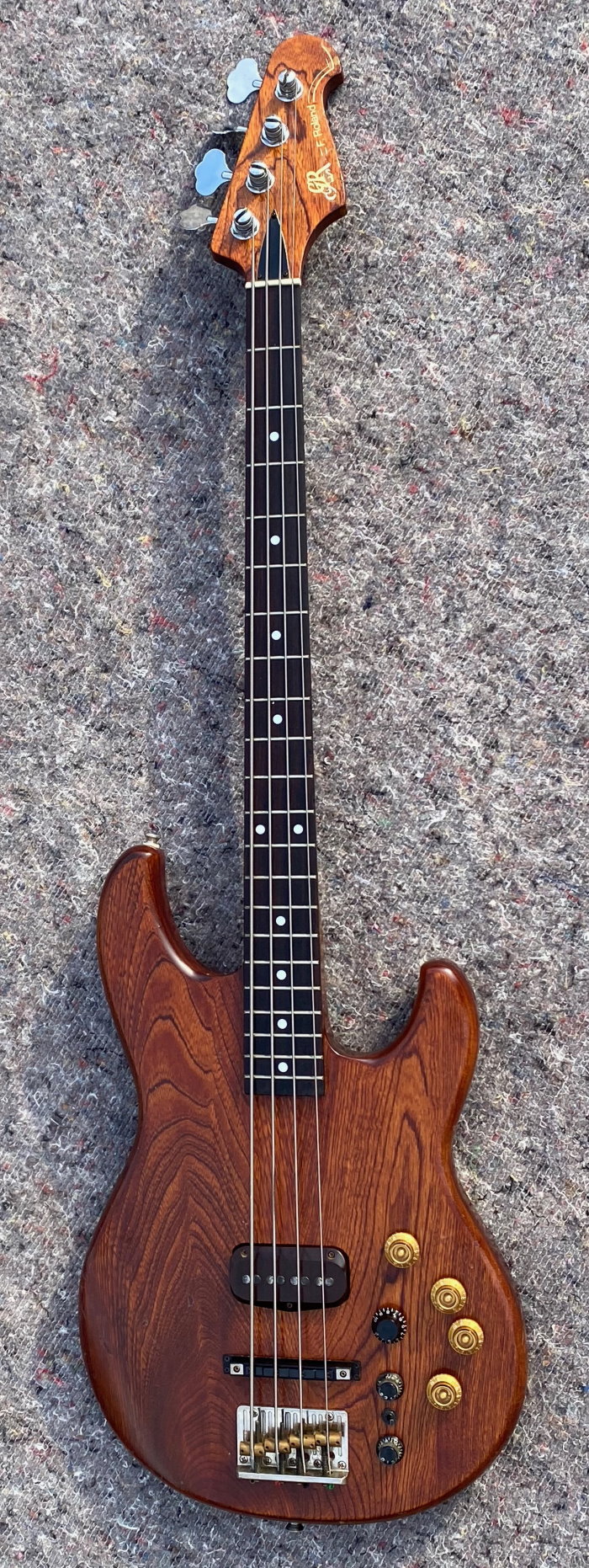

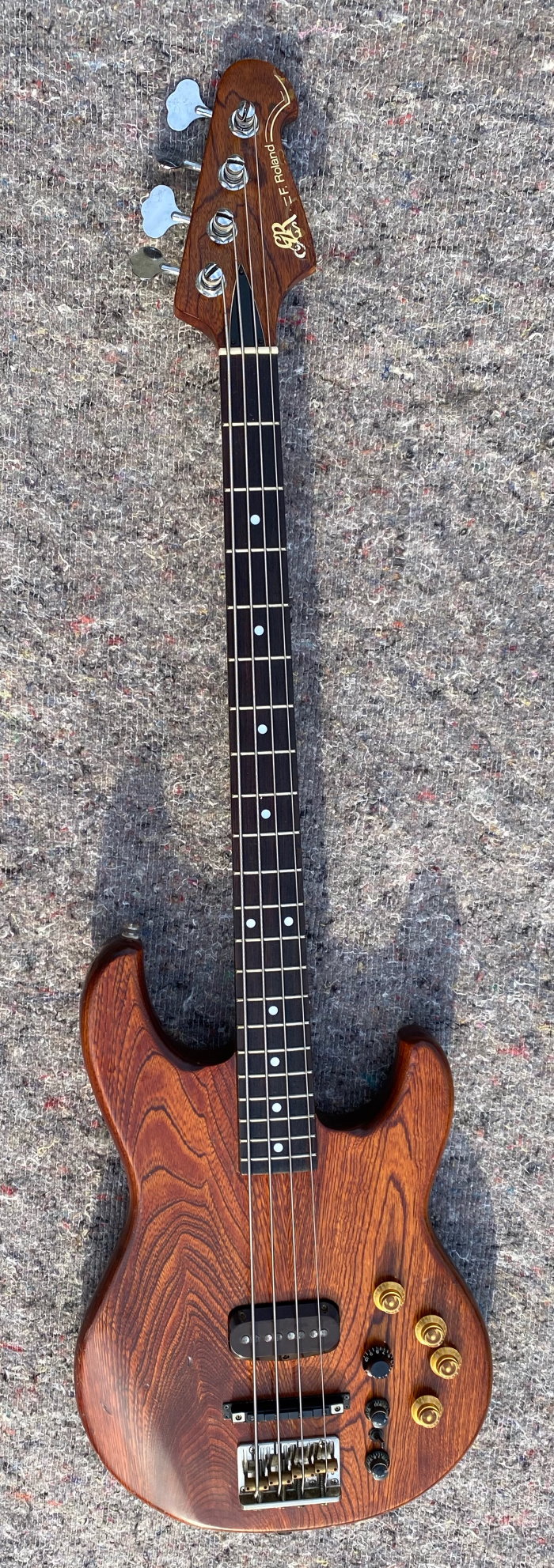


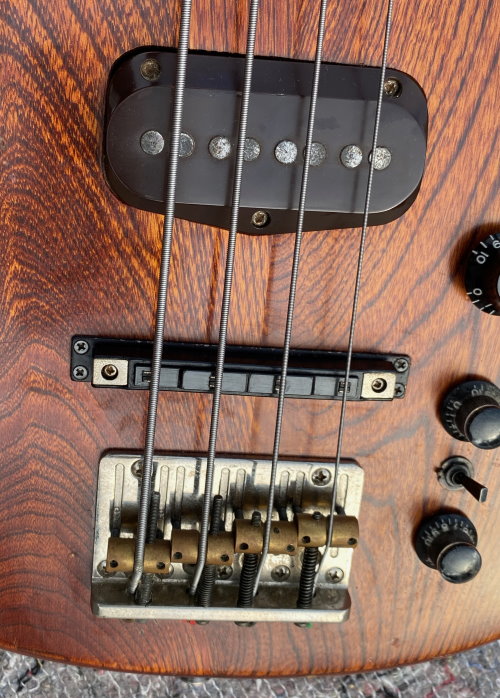












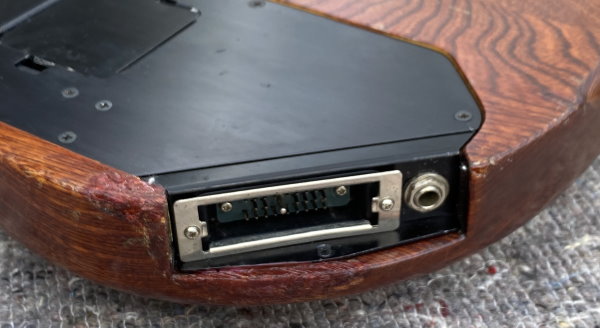





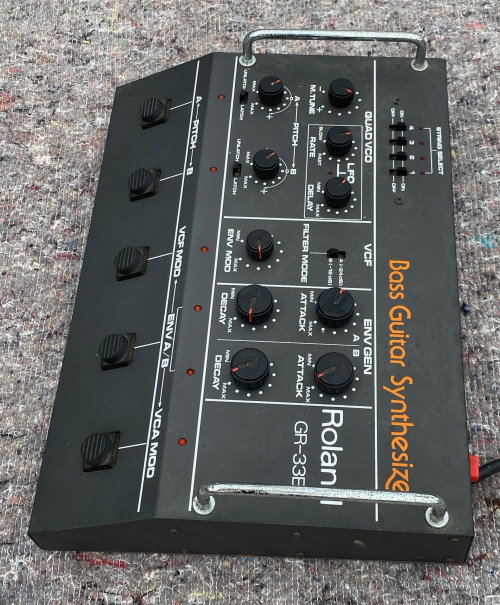




1982 ROLAND G-33 BASS and GR33B 117 VOLTS Synt in working conditions, some ding&dong and wear near the connector Comes in Original Case and with Bass-Synt Connection Cable code Ba633
ROLAND BASS G-33 series In very good conditions all working well, perfect neck and frets 1 11/16" at the nut. original PU-144S single coil pickup sounds full, clear, and wonderfully articulate Ready to play. Wheight 4,241Kg
The GR-33B was packaged with the G-33 or G-88 bass guitar controller. Like the G-303 and G-808, the basic design of the bass guitar is the same for the G-33 and G-88. The G-33 and G-88 electronics package has master volume and two bands (high and low) of active equalization. When connected to a Roland guitar synthesizer, the active electronics are powered by the synth. When used alone, two nine-volt batteries supply power.The G-33 has a rosewood fingerboard and set-neck construction. And, like the G-303, the G-33 has nickel/aluminum alloy nichrome plated hardware. The 1982 Roland guitar synthesizer brochure notes that the G-33 has a Roland PU-144S single-coil pickup.The G-33/G-88 bass guitar, like all the vintage Roland guitars, was built by the Fuji Roland corporation, a joint venture by Roland and the Fujigen Gakki. Fujigen Gakki (now known as FGN guitars) also made the Ibanez guitars
4-voice polyphony 2 oscillators per voice VCOs (voltage controlled oscillator) are directly harmonically locked to each string, but can be tuned separately VCF (voltage controlled filter, low pass), 2 modes, -12 dB or -24 dB per octave, with envelope modulation (attack and decay) Low Frequency Oscillator with lag (delay) generator Built-in foot switch controls the VCF or VCA modulation Built-in foot switches control the VCO harmonize pitch (detuning of the VCO's) Built-in foot switch selects envelope presets A or B Pedal control input for the VCF The GR-33B can output either the guitar, the synth, or a mix of the two Synchronized, flashing LED status indicators Dimensions: 15.75" (W) 11.125" (D) 4" (H) Power Requirements: 20 watts Response Time: 13.00 ms
The Roland GR-33B is the bass guitar version of the GR-300. Some changes were
made to meet the specific needs of bass players. Also, there is no hex fuzz
circuit.
The
GR-33B also has two selectable envelopes, and a choice of VCF and/or VCA
modulation. While the GR-300 has a -24 dB per octave filter, and the GR-100 has
a -12 dB per octave filter, the GR-33B actually has both, with a switch to
select -12 dB or -24 dB operation.
Learn
more about the design of the GR-33B -12/-24 dB per octave IR3109 filtering
section on the GR-100 page.
There
is no pitch sweep like on the GR-300. The GR-33B has a very cool variable LFO
delay. This delay follows the envelope generator. This means you can play a note
and hear the LFO quickly or slowly swell in. Playing notes rapidly means that
you will not hear the vibrato effect. It is very expressive, and makes sense for
the bass player that may not want constant vibrato. If you check out the
Frankenstein demo, you will hear vibrato swelling in on the main line. I did not
use the touch pads to activate the vibrato each time I played the phrase, but
instead set a short delay so the vibrato would swell in on the longer quarter
notes in the melody. .
From
the Roland 1982 Brochure
The
GR-33B sounds very much like the GR-300. If you compare the block diagram for
both synths, you will see that they are basically the same. Likewise, the synth
response time for the GR-33B is very fast, like the GR-300. I did a few timing
checks when recording demos for the GR-33B, and the delay was in the range of 2
- 4 milliseconds. This is the kind of speed that a digital synth could only
dream of.
I
would like to mention that I really wish the GR-33B provided access to the
square wave output. Like the GR-300, the main output is an unusual ramp waveform.
When the duet mode is engaged, you can hear a square wave and the ramp wave. The
problem is the aggressiveness of the ramp wave. It is much more like a brass
wave, than the buttery smooth sound of a classic Minimoog bass patch. You can
filter the ramp wave to eliminate the aggressiveness, but the waveform becomes
very dark with few harmonics. You can hear this sound in the VCF and VCA
modulation demos below. The Frankenstein demo also shows off the aggressive
sound of the GR-33B.
Finally,
the response of the GR-33B system has some uneven areas compared to the GR-300,
which has flawless tracking. In particular, playing the low E and low A strings
can confuse the synth tracking system. The problem does not seem noticeable with
the D and G string. I spent an entire weekend testing my system before
concluding that the GR-33B is pushing the limits of guitar synth technology with
the low notes. Mark Smart, a serious musician and guitar synth genius reported
to me that his main problems with tracking came from the lowest notes. And I was
able to exchange emails with Pablo Leocata, another serious GR-33B user who
reported similar playability. Depending on how you play, this could be
unnoticeable, or an annoying inconvenience. My theory that this issue has to due
with the different quality in sound from the open strings to the fretted strings.
Body: Ash
Finish: Acrylic, "Robert" brown
Neck: Maple set-in
Fingerboard:
Rosewood
Frets: 21
Bridge: Adjustable
Nut: Polycarbonate
Tuning machines:
Gotoh
Pickups: One Roland PU-144S single-coil
Scale: 34"
Truss Rod: Single,
Adjustable
Neck Width: 1 11/16"
Body Width: 13"
Body Depth: 1 3/4"
Overall
Length: 45 1/2" The Roland GR-33B is the bass guitar version of the GR-300. Some
changes were made to meet the specific needs of bass players. Also, there is no
hex fuzz circuit. The GR-33B also has two selectable envelopes, and a choice of
VCF and/or VCA modulation. While the GR-300 has a -24 dB per octave filter, and
the GR-100 has a -12 dB per octave filter, the GR-33B actually has both, with a
switch to select -12 dB or -24 dB operation The Roland GR Series Analog Bass
made in the Fuji Roland Factory. Weight- 8.5lbs code Rol33Ba See the web site:
joness.com/gr300/G-33.html
https://www.joness.com/gr300/G-33.html
http://www.roland-museum.de/gitbs/html/G88/Roland_G88_ro.php
http://www.roland-museum.de/gitbs/html/G33/Roland_G33.php?l=d
https://www.youtube.com/watch?v=Je8iY_aHzfE
https://www.youtube.com/watch?v=j43UQWNhzek
